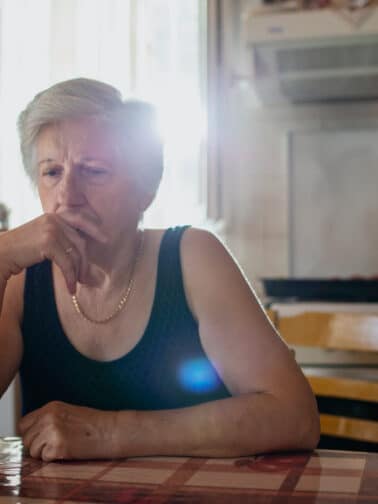“My wife and I have a good relationship. It’s not perfect but what is? I love her and mostly feel really close to her. Sure, we fight like all couples but we’re pretty good at making up afterward and working through it. It’s taken time, of course, but we’ve got a good marriage.”
Reading these vignettes above, could you see yourself in any aspect of them?
All of these vignettes describes a different kind of attachment style – the pattern we have in our close relationships (romantic, close friendships, family, etc).
We all have an attachment style and the four types of attachment styles are anxious-ambivalent, anxious-avoidant, disorganized, and secure.
While many of us will see ourselves heavily in one attachment style, it’s also possible to see yourself in two or more of these styles at some points.
We “learn” our attachment style based on our early childhood experiences which means that, for those of us who may have come from dysfunctional, neglectful, or relationally unsupportive homes, the chances are high that we might not have learned secure attachment, but, instead, learned and absorbed one of the other styles.
The challenging aspect of this is that when we have an attachment style that’s not secure, it can create challenges in our emotional lives and in our relationships, leading to a host of impacts including frustrated and interrupted longings for intimacy, chaotic or unstable relationships, etc..
The good news is this: secure attachment can be learned and earned no matter what style you have today.
To learn more about these four attachment styles and to learn what it may take to become more securely attached, keep reading.
What are the four attachment styles?
Attachment theory – a psychological model pioneered by British child psychiatrist John Bowlby, MD that addresses how we as humans respond in relationship when we feel stress or perceive a threat – is, quite simply, the dominant patterns of relating to others that play out in our lives.
Our attachment styles are informed by our early childhood experiences and the “relational template” we picked up from our parents, caretakers, or other significant early influencers.
Attachment theory essentially says that infants will bond to any primary caretaker they are presented with and it’s this caretaker who is critical for the caretaker’s emotional and social development.
Now, please understand, attachment theory doesn’t aim to put even more pressure on parents/caretakers by implying that you have to be a “perfect” caretaker.
That’s not the goal (it’s also impossible).
The goal instead is to be a good-enough caretaker who can repair ruptures with the infant and child when they happen (as they inevitably will).
But when this doesn’t happen, when a parent or caretaker repeatedly and egregiously fails to attune and repair after rupture and where there is outright abuse and neglect of an infant, that impacts the infant’s sense of secure attachment.
The bottom line is this: infants and little children are powerless.
Truly. They cannot “leave” the relationship with the adult when they are mistreated or not getting secure enough attachment.
But they can adapt. They can cope and manage that less-than-good-enough relationship in a variety of ways and behaviors that, ultimately, can correspond to an attachment style.
Attachment theory was further developed upon and refined by psychologist Mary Ainsworth, Ph.D. – a student of Bowlby’s – during her work in the mid 20th century when she identified four main attachment styles, some of which are famously illustrated in The Strange Situation experiment.
These four attachment styles more specifically are secure, anxious-ambivalent, anxious-avoidant, and disorganized.
Attachment Styles In Brief
Secure attachment.
People with secure attachment, in general, find it relatively easy to become emotionally close to others and to let others become close to them.
Secure attachment allows individuals to feel comfortable with both independence and with intimacy.
Securely attached individuals are comfortable depending on and being depended upon by other and largely tend to have a positive view of themselves and of their relationships.
Secure attachment is learned through parenting and caregiving that is appropriately (remember, not perfectly) attuned to the child’s needs.
Anxious-Ambivalent
Anxious-ambivalent attachment is characterized by a need for high degrees of responsiveness, attunement, and reassurance from their attachment figure.
Folks with this style of attachment may feel a great deal of anxiety when they are separated from their attachment figure or when the bond between them is ruptured or perceived to be ruptured.
The anxiety can usually only be remedied with renewed contact with the attachment figure.
Because of this, individuals with an anxious-ambivalent attachment style can become overly dependent on their attachment figure
In contrast to securely attached individuals, those with an anxious-ambivalent attachment style may not have as high of a regard for themselves or their capacity to be in relationship.
Anxious-Avoidant
People with this kind of attachment style may be characterized as wanting and requiring a high degree of independence and self-sufficiency.
Fundamentally they do not believe it is safe to be emotionally close and so guard themselves against intimacy by not seeking out relationships or pushing intimacy away when it is presented and distancing themselves from the attachment figure.
In general, people with an anxious-avoidant attachment style feel discomfort being depended on and depending on others.
Likewise, they may not have high regard for themselves or relationships in general.
Disorganized
As you may have already guessed, individuals with a disorganized attachment style have a combination of characteristics of both the anxious-avoidant and anxious-ambivalent attachment styles.
For instance, they long for closeness (anxious-ambivalent) but also paradoxically fear closeness (anxious-avoidant). This can lead to chaotic and inconsistent responses when presented with intimacy.
As with anxious-ambivalent and anxious-avoidant types, people who have disorganized attachment styles tend to have a lower degree of regard for themselves and for relationships.
Seeing Yourself In An Attachment Style
Again, these are the four main attachment styles in brief. There is much more I could write about each style but perhaps even in these brief summaries, you saw enough of yourself to identify with them.
However, if you’re unsure which style you largely possess and are interested in learning more and even taking a test or questionnaire to help guide you to your style, there are a variety of resources out there.
Those that I recommend include this one – the original attachment three-category measure by Feeny, Noller and Hanrahan – or this one by Dr. Diane Poole Heller (be advised you need to enter your email at the end to receive your results).
But, regardless of how or if you choose to learn more about which attachment style you predominantly have, the big question for most of us who can’t necessarily identify with being securely attached is: So how do I become more securely attached?
I dive deep into this question in my next blog post in two weeks’ time so please keep an eye on your inbox to learn more.
If you would like additional support with this and you live in California or Florida, please feel free to reach out to me directly to explore therapy together. You can also book a complimentary consult call to explore therapy with one of my fantastic clinicians at my trauma-informed therapy center, Evergreen Counseling.
Or if you live outside of these states, please consider enrolling in the waitlist for the Relational Trauma Recovery School – or my signature online course, Hard Families, Good Boundaries, designed to support you in healing your adverse early beginnings and create a beautiful adulthood for yourself, no matter where you started out in life.
And until next time, please take very good care of yourself. You’re so worth it.
Warmly, Annie






I’ve been getting your newsletters for awhile now and I must say, I look forward to them! Every one has been eye-opening and helpful. This one on attachment theory is really intriguing! If I had to guess, my spouse is on the Anxious-Ambivalent side and I’m on the Anxious-Avoidant side. We are learning how to have time together. Recently we get to the end of a weekend and he’s not feeling close, and I’m exhausted and so ready for him to go back to work. I’d thought it was an introvert/extrovert issue, but running the replay on some of our common fights, I think this may be more of the trigger! I’m interested to read the next post! Thanks for sharing your wisdom with us!
Hi Stephanie,
First of all, thank you for being a long-term blog reader! It warms my heart to hear that my posts feel helpful to you. And yes! I’m glad this attachment article provided you with a new/different lens to look at interactions with your spouse. I think it can be really helpful to question what uncomfortable or less-than-functional patterns and habits in our relationship can be attributed to attachment. I hope you find the next post helpful!
Warmly, Annie